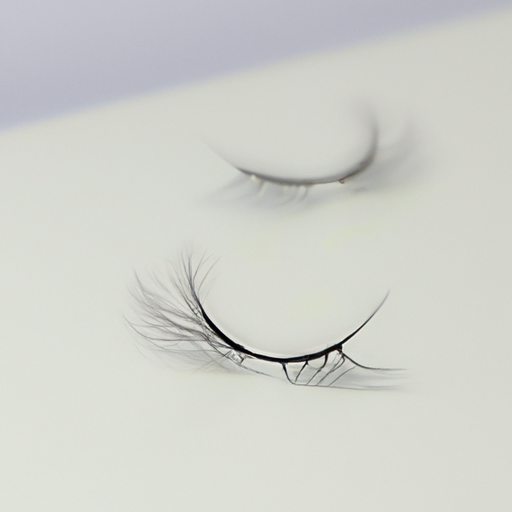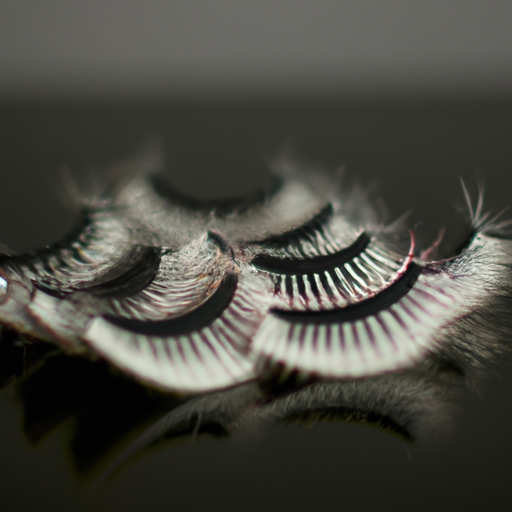As anyone who’s ever experienced sensitivity to their eyes knows, finding the right false eyelashes can be a real struggle. I mean, it’s one thing to have sensitive skin around your eyes; it’s another ballgame entirely when it comes to dealing with delicate eye tissue. But choosing the wrong type of false lashes can be a real nightmare – from inflammation and redness to a full-on allergic reaction. So, if you have sensitive eyes, it’s essential that you take the time to learn about different types of falsies and how best to care for them. Here, I’ll give you an overview of Sensitive Eyes, discuss the importance of picking the right false lashes, and provide tips on how to select the ideal pair. Let’s get started!
Understanding Your Eye Type
As a sensitive-eyed individual, it’s important to understand the foundations of your eye type. Different sensitivities can be triggered by different external factors and it’s not always easy to know how your false lashes will react. Knowing your eye type allows for easier decision making when it comes to selecting the right false lashes for you.
At the core of sensitive eyes lie triggers. These can include any material that is too abrasive or harsh on the lash area, as well as lack of moisture, increased exposure to air pollutants, allergies and any other kind of reaction. When considering what false lash fits best with your eye type, make sure to familiarize yourself with its ingredients and determine if any of them can cause irritation.
In addition to understanding potential triggers, there’re a few other key factors to consider when picking the right fit. Most importantly, the length of the lashes. Too long and they may weigh down your natural lashes. Too short, they won’t provide enough volume or definition. Also, look at the width of the band. A thicker base provides more stability, but can be uncomfortable with sensitive eyes. On the flip side, thinner bands are lighter, but may not hold their shape as much. Finally, consider how flexible the material is. Flexible materials may be softer on your eyes, whereas stiffer materials may offer more definition.
Selecting the Right False Lashes
False lashes can be a great way to glam up your look and add volume and length to what you already have. But for those of us with sensitive eyes, it’s important to select the right kind of false lashes.
We all have different eye types and sensitivities, so knowing how your eyes react to certain products and triggers is essential. First, start by figuring out what causes your eyes to become irritated. It could be dust, pollen, chemicals in cosmetics or fragrances, or even just long-wearing makeup.

When selecting the right false lashes, there are a few factors to consider, such as the type of lash material, the size and shape, and the adhesive. Natural lash extensions are best for those with sensitive eyes because they don’t contain any harsh chemicals or glues. Synthetic lashes also tend to be softer and lighter than other types. Mink lashes are popular because they look natural and feel lightweight, but these are typically more expensive and are not suitable for those with very sensitive eyes.
Once you’ve chosen your false lashes, the importance of taking proper care of them can’t be emphasized enough. Make sure to clean the lashes after each use and remove them correctly to avoid irritating your eyes. Additionally, keep in mind that many adhesives contain chemicals that can irritate the eye, so opt for a hypoallergenic option if you’re particularly sensitive.
Finally, follow these tips for prolonging the life of your false lashes: store them in their original packaging; apply mascara sparingly; and avoid sleeping with them on. Doing all this will help ensure that you get the most bang for your buck and enjoy the gorgeous lash looks you’re after without compromising your comfort!
Caring for Your False Lashes
So, you’ve invested in a gorgeous set of false lashes. Now what? You want to ensure that your new look lasts as long as possible, so proper lash care is key! Here’s how to make sure your lashes last:
Cleaning and removing false lashes can be tricky. To keep your falsies looking fab, it’s important to clean them regularly. After each use, soak a cotton pad with makeup remover or oil-free eye makeup remover, then carefully loosen the glue on the band and remove the lashes. Make sure to use an oil-free product, as oils will break down the adhesive.
Using tweezers, gently remove any excess glue and residue, taking extra caution not to pull too hard or damage the lashes. Soak a second cotton pad in saline solution and pass through each individual lash to disinfect. Then, wrap each lash around your finger or a spoolie brush, and lay them out to dry.
When reusing, apply a thin line of eyelash adhesive along the lash line and let sit for 30 seconds. Then, using tweezers, attach the band to your upper lashline, making sure the ends are evenly distributed. For extra security, you can finish the look with mascara.
In addition to regular cleaning, there are a few tips to keep your lashes lasting longer. When applying mascara, use a light hand and avoid harsh scrubbing, which can weaken the fibers. When sleeping, also make sure to place your head on a satin pillowcase to reduce tangling. Finally, store your lashes in their case when not in use, as this will help maintain their shape and integrity.
Your false lashes don’t have to be a hassle! With proper care and maintenance, your fake lashes will stay beautiful and last longer. Follow these easy steps and you’ll be well on your way to looking fabulous.
Conclusion
When it comes to achieving bombshell eyes without the eye-ache, the key is picking the right false lashes for your sensitive eyes. It’s crucial to identify triggers that could cause discomfort and then select the type of lash extensions to suit your eye type. Natural lash extensions are generally recommended for people with sensitive eyes since they’re lightweight. Synthetic lashes can also work great – just make sure to check reviews from customers who have experienced sensitivity with falsies! Last but not least, mink lashes look stunning, but may cause irritation for those with sensitivities.
Overall, selecting and caring for false lashes properly can ensure you get the luscious look you’re after…without the dreaded sensitivity repercussions. So go ahead and dare to bat those beautiful peepers; the secret’s out—false lashes and sensitive eyes don’t have to be a hazardous combination!
False Lash Sensitivity FAQ
How do I know which false eyelash goes on which eye?
When it comes to finding the right false lashes for sensitive eyes, the decision can be daunting. But, by following a few simple steps, you can find the perfect pair for your particular needs.
The first thing to consider is the material of the lashes. Synthetic lashes are usually lighter and more comfortable on the eyes than human hair lashes, but they can also irritate sensitive eyes. If you have particularly sensitive eyes, opt for a pair of natural false lashes, which are generally made from mink or silk. These are softer and more lightweight, with less of a chance of causing irritation.
Next, consider the shape of the lash. Certain styles, such as cat-eye or dramatic lashes, can weigh down delicate eyelids and tug on sensitive eyes. Opt instead for a more lightweight and natural style, like a half-lash or a subtle length.
Finally, look at the adhesive used to attach the lashes. It’s important to choose a lash glue that won’t irritate sensitive eyes. Look for formulas that are latex-free, hypoallergenic, and free of harsh chemicals.
By taking the time to do your research and find the perfect pair of lashes for sensitive eyes, you can rock that eye-catching look without irritating your eyes.
What are the easiest false lashes to wear?
When it comes to choosing the right false lashes for sensitive eyes, the best advice I can give is to start simple. Go for lashes that are natural looking, with a thin band and subtle curves. Steer clear of thick, heavy lashes and anything with glitter, rhinestones, or artificial coloring. When you’re selecting a lash set, look for ones that are made of light, synthetic fibers like nylon or silk and are comfortable and light enough to wear. They’ll be less likely to irritate your eyes and remain put all day.
I suggest doing a spot test to make sure the lash set you’ve chosen isn’t too harsh. Take a single lash and wear it out for a few hours. Pay attention to how your eyes feel and look afterwards. If you’re suffering from redness, irritation, or swelling, it’s time to swap out the lashes. To prevent further irritation, use a hypoallergenic, latex-free glue.
For an extra layer of protection, always select lashes that don’t come with a heavy strip at the base. They can easily fall into your eyes and cause discomfort, so opt for a strip that’s light and flexible. You can also look for lashes that come with a lash line, which is a pair of false lash pieces that attach right onto the lash line, creating a more natural look and feel.
Overall, choose careful when selecting false lashes for sensitive eyes. Start slowly and find a product that offers lightweight and comfortable wear. Test out the lashes beforehand and look for ones that come with a lash line. That way, you can find the perfect pair of lashes, without risking any discomfort or irritation.
How do you wear eyelashes with sensitive eyes?
For those with sensitive eyes, choosing the right false lashes to enhance their look can be more difficult than for those who don’t have sensitive eyes. But don’t give up hope – with the right tips, you can have beautiful, fluttery lashes even if you have sensitive eyes.
First, look for hypoallergenic lashes — ones that are made with synthetic materials. These will be gentler on your eyes and won’t cause any irritated reactions. Also, consider individual or cluster lashes instead of a full strip lash — these can be easier on the eyes, since they’re applied one at a time. And if you opt for a strip lash, look for one that has a light, flexible band that won’t feel too heavy when applied.
Secondly, make sure to use a good quality adhesive — one that is specifically designed for sensitive eyes. This will ensure that the adhesive won’t cause any irritation or redness in your eyes. And speak to your eye care professional before you start wearing eyelashes, to make sure your eyes are healthy enough for the process.
Finally, apply your lashes with care — use tweezers to apply them carefully and gently to avoid pulling on your lashes too much. And remember to always be sure to take the false lashes off before bed so you don’t leave them on overnight, and give your eyes a break.
By taking these steps, you can enjoy the look of false lashes even if you have sensitive eyes!



